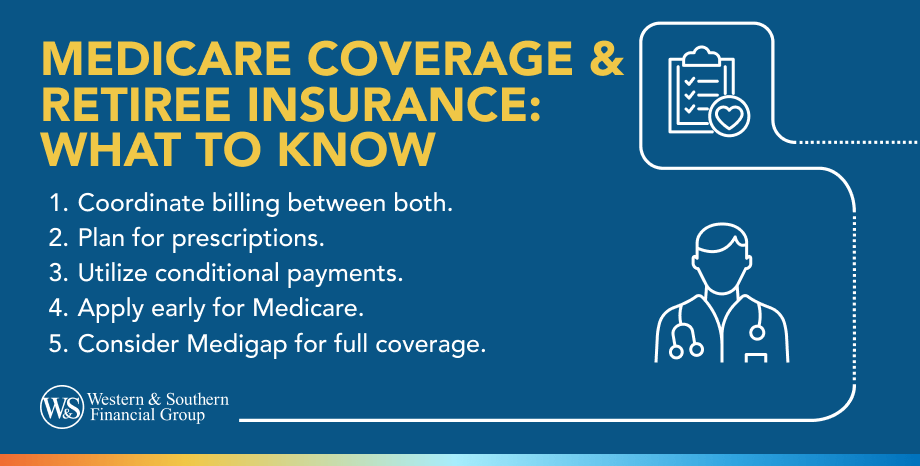

Table of Contents
Key Takeaways
- Coordinate billing between Medicare and retiree insurance.
- Plan ahead for prescriptions to avoid penalties.
- Utilize conditional payments to safeguard your wallet.
- Early Medicare enrollment prevents late fees.
- Consider Medigap for comprehensive coverage.
For those already enjoying their retirement — or those planning for the next chapter — determining how much they needed to maintain their lifestyle can get complicated. And when health insurance is added to the mix? Well, that may make things a little more complicated.
Planning is an important first step for any big journey. Medicare coverage, in particular, has many moving parts — and if you decide to keep your regular insurance while signing up for Medicare, you could end up with piles of paperwork you might not understand.
So, here are five things you need to know about how Medicare coverage works with retiree insurance and how to simplify the process.
1. The Billing Lineup
Bills are a necessary part of life, so consider making things easier on yourself by learning how health care billing works. The retiree insurance you have will be secondary to your Medicare coverage, according to Medicare.gov.1 If you go to the doctor, for example, the bill would be sent to your Medicare insurance carrier first. Whatever they don't cover would then be sent to your other insurance carrier.
To avoid any confusion, consider making it clear to your doctors and other health care providers that you have both retiree coverage and Medicare so they will know how to bill accordingly. Reading through the benefits package could help give you a more thorough understanding of how your retiree coverage will work with Medicare.
2. Prescriptions: Planning Ahead
You can have multiple prescription drug policies at any time, but you can only use one policy per drug. And any drug coverage should be at least as good as the standard of Medicare Part D.
You'll be subject to a penalty of one percent (of the national base premium) every month you delay enrollment if you go more than 63 days without adequate prescription coverage and choose to sign up for Medicare Part D later, according to the AARP.2 There's a limited open-enrollment window to sign up for Medicare Part D, similar to what you have with regular insurance.
Open enrollment is generally between October 15 and December 7, according to Medicare.gov.3 It might be good to start preparing months in advance so that your coverage starts as soon as you're eligible. Planning could help you avoid any unnecessary fines — and you could spend those funds on something else instead.
3. Conditional Payments Could Safeguard Your Wallet
If your health insurance company is taking a long time to process a payment — or if your doctor's office bills your Medicare policy when it should have billed your retiree insurance — Medicare could make a conditional payment on your behalf.
This payment would need to be repaid once your other insurance pays the bill. It could help to keep track of any receipts, bills and statements you receive to prove that Medicare was repaid any conditional payments it made. You could also consider contacting your doctor's office so they know which insurance to bill first to avoid this hassle in the future. As with many things in life, the best defense is a good offense.
4. The Early Bird Avoids the Late Fees
It could make things easier if you sign up for Medicare as soon as you're eligible — even if you're happy with your supplemental coverage. That way, you could avoid paying a late penalty.
If you are enrolled in the Department of Veterans Affairs program (and have a VA card or other federal benefits), you should also consider signing up for Medicare as soon as you can — usually when you turn 65 or if you start receiving Social Security disability payments. The enrollment period generally begins months before you turn 65, however, which could give you plenty of time to enroll and register.
Something else to keep in mind? Some insurance policies won't pay for any of your expenses if you were eligible for Medicare but didn't sign up, so it's probably a good idea to sign up early to avoid paying those bills yourself.
5. Medigap: For Everything Else
People who have Medicare and want more help paying for it can purchase Medigap, also known as Medicare supplement insurance. This is a form of insurance sold by private insurance companies to help pay for the extra costs Medicare doesn't cover. Medigap could provide coverage for circumstances like traveling abroad and could pay for the parts of Medicare you're responsible for, including deductibles, coinsurance and other out-of-pocket expenses.
Another form of additional coverage is Consolidated Omnibus Budget Reconciliation Act (COBRA). Let's say you have retiree coverage, but the employer providing your coverage ceases to exist. What would happen? Well, you might still be eligible for COBRA coverage. This could depend on whether the organization is offering COBRA to other employees. If you can't sign up for COBRA, you might be able to purchase a Medigap policy, even if the window for Medigap eligibility is closed.
The Bottom Line
By equipping yourself with knowledge about how to work with both Medicare and your retiree insurance, you could better understand how to get the most out of your health care coverage in retirement. That could leave you extra time to do the really important things — like spending quality time with loved ones, planning new adventures and enjoying your golden years to the fullest.
Sources
- Retiree insurance. https://www.medicare.gov/basics/get-started-with-medicare/medicare-basics/working-past-65/retiree-insurance.
- Do I need Medicare Part D drug coverage if I don’t take any prescriptions? https://www.aarp.org/health/medicare-qa-tool/i-take-few-meds-do-i-need-a-part-d-plan/.
- Joining a plan. https://www.medicare.gov/basics/get-started-with-medicare/get-more-coverage/joining-a-plan#collapse-3190.















